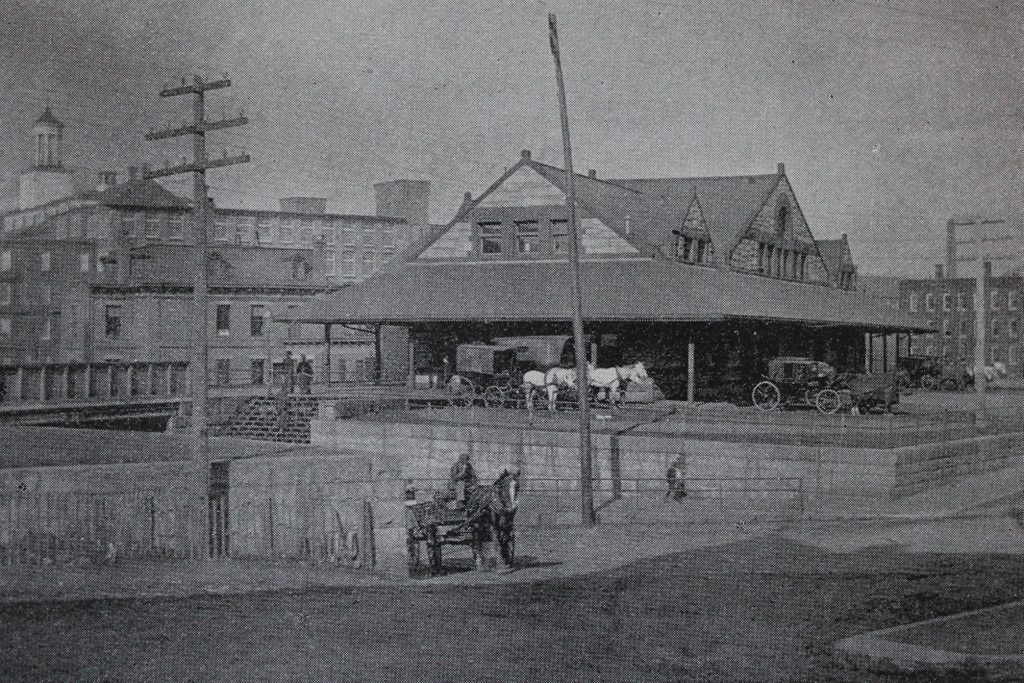The Connecticut River Railroad station, seen from the corner of Bowers and Mosher Streets in Holyoke, around 1892. Image from Picturesque Hampden (1892).
The scene in 2017:
Railroads came to Holyoke in 1845, when the Connecticut River Railroad opened from Springfield to Northampton. This coincided with the area’s development into a major industrial center, and within a few years the canal system was completed and the first few mills were operational. The first passenger station was a small wood-frame building at the corner of Main and Dwight Streets, near where the modern Amtrak station is located, and it remained in use for about 40 years. However, Holyoke’s population grew exponentially during this time, from around 3,200 in the 1850 census, to over 21,000 by 1880, and the original station had become inadequate for the needs of the city.
In 1885, the Connecticut River Railroad opened a new passenger station here on the east side of the tracks, bounded by Mosher, Bowers, and Lyman Streets. It was designed by Henry H. Richardson, who was one of the most important American architects of the 19th century, and it was one of the many railroad stations that he designed across the state during the early 1880s. Richardson was a pioneer of Romanesque Revival style architecture, and his station incorporated many common elements, including the rough-faced granite exterior, the brownstone trim, a complex roofline, and arched windows.
On the interior, the central part of the station included the main waiting room, which occupied about half of the ground floor. There was also a separate ladies’ waiting room, and a room that, on the original floor plans, was labeled “Emigrant’s Room.” The latter was evidently used to screen and administer smallpox vaccinations to incoming immigrants, who comprised a large portion of Holyoke’s population during this time. Other facilities inside the building included a baggage room, a ticket office, and a telegraph office, along with several restrooms.
The first photo was taken around 1892, only a few years after the station was completed, and it shows the view from the southeast, from the corner of Bowers and Mosher Streets. About a year later, in 1893, the Connecticut River Railroad was acquired by the Boston and Maine Railroad, and the station became part of an extensive rail network that spread across northern New England. During this time, the station continued to play an important role as the point of arrival for many immigrants to Holyoke, including large numbers of French-Canadians who traveled south along the railroad from Quebec, in search of jobs in the factories here.
The station remained in use throughout the first half of the 20th century. However, Holyoke’s economy began to decline by the middle of the century, with many of the factories closing or relocating. Passenger rail travel suffered as well, both here in Holyoke and in the country as a whole. Cars and airplanes began replacing trains, and ridership continued to decline. The station closed in 1965, and passenger service on the line ended just a year later.
Following its closure, the former station was converted into an auto parts store, and at some point the platforms were enclosed on the southern side of the building. Passenger service would not return to Holyoke until 2015, after Amtrak’s Vermonter was rerouted through the city, but the plans did not involve restoration of the old station. Instead, a new one, consisting of just a single covered platform, opened a little to the south of here, near where the original 1845 station had stood. In the meantime, the old station has been vacant since at least the early 2000s. It is currently owned by Holyoke Gas and Electric, and has been the subject of various redevelopment proposals, although none of these have begun yet.



Great article any chance that you have more information that you can send me please do thank u
I don’t really have any additional information beyond what I included in the article, but my understanding is that it was recently purchased by a private owner with the goal of restoration.
I am actually working in the building right now the new owner’s name is David White we are cleaning painting he’s not sure what he’s going to do with the building but it looks like ice cream shop or a restaurant…..
Any update on the building? I’m planning a trip to MA is Spring of ’22 to visit and photograph Richardson’s buildings.
Hey Anthony would like to hear more about your photo project. I’m currently living in Holyoke and working in the Lyman Mill buildings.
I worked in this building when it was the automotive machine shop in the 80. We had a old timer that left the station when he went to war then came back in his later years to work in this building. I always love older buildings and history. I walked every square inch of this building from the top down. It’s so cool of a building. A Chines company back in the 80 wanted to purchase this building and turn it into a museum or something but the owner said no. What a shame. I would love to be able to walk in some day and see it. I have some old story’s I love to share that had been shared to me from the old timer when I worked with him.
Richard, I am involved in the restoration of the Holyoke Train Station and would welcome information and stories you have about it. will dot melton at mac dot com
Love that state, the people and the area.
I was working in texas fopr 3years, and hat an IT training in Springfield for 3 weeks.
It was the time for indian summer, it was great.
Go on with those articles. 🙂
Hi Will
Just seeing this I will Rich out soon. My email is richkorell@gmail.com
So where did you find info on the interior?